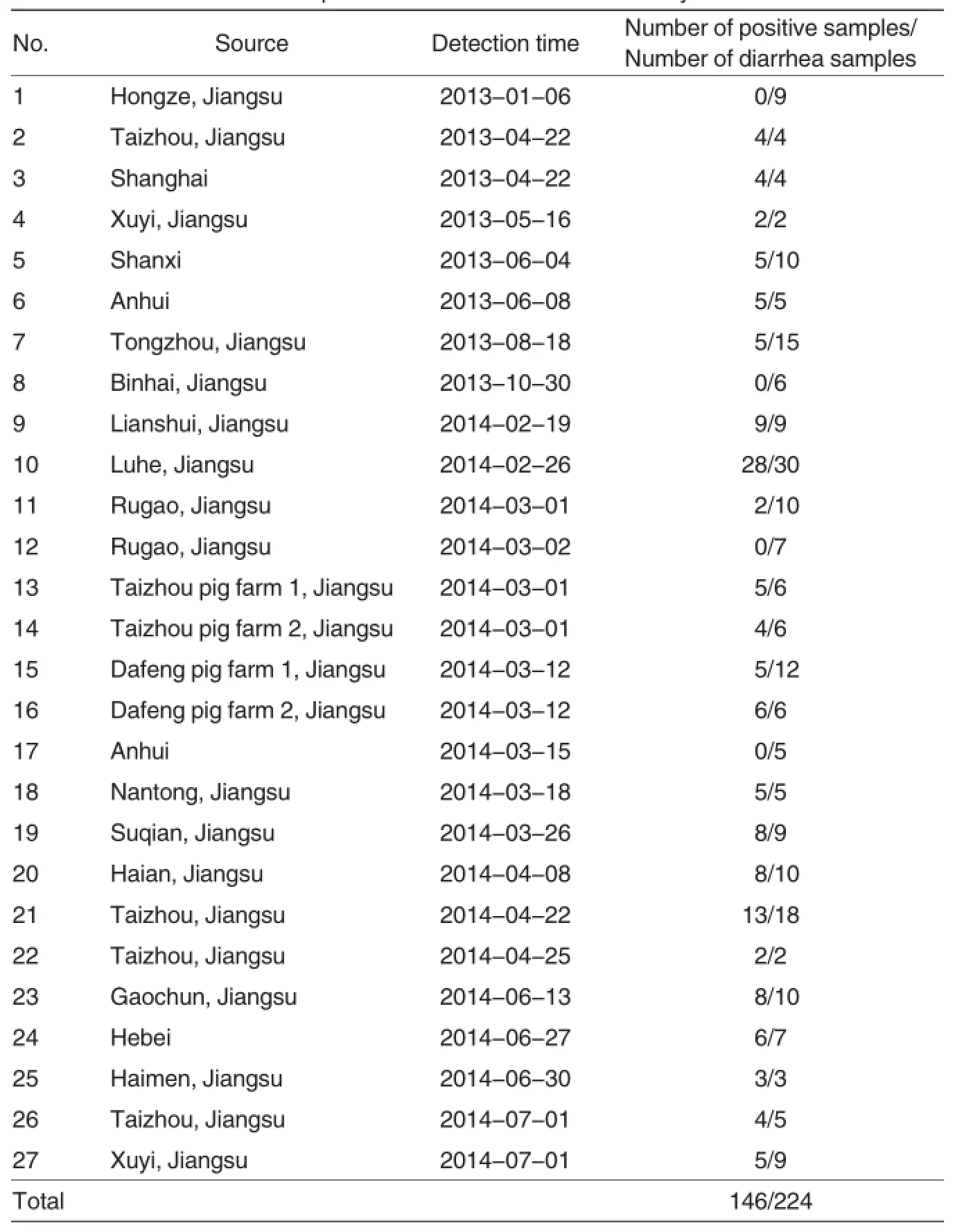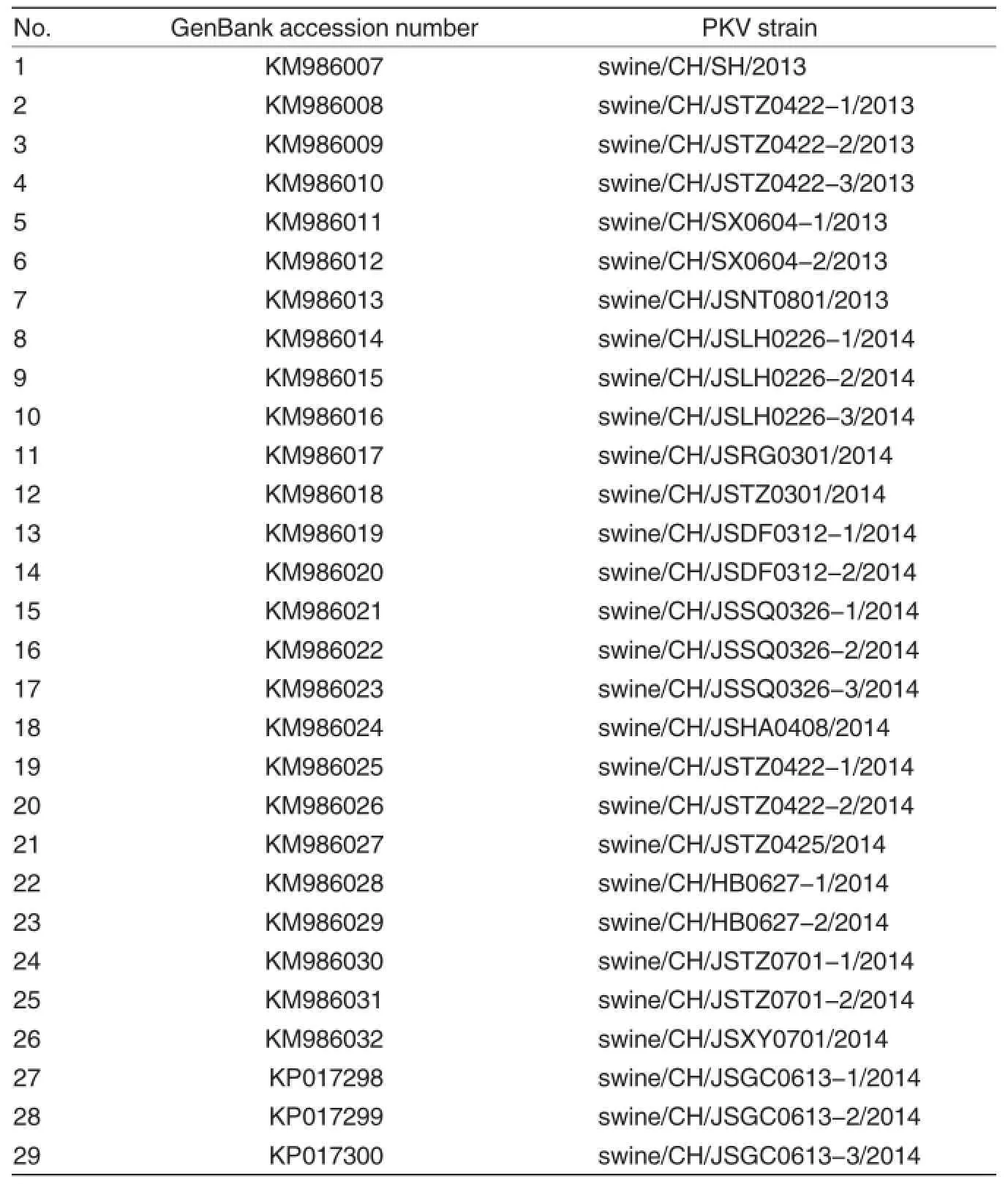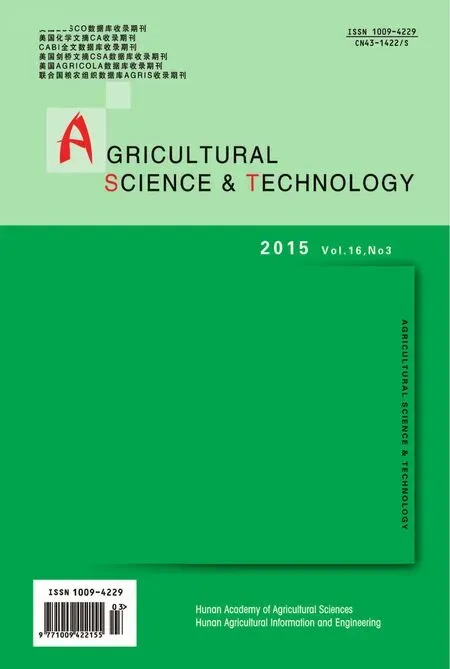Genetic Variation Analysis of 3D Gene and Molecular Detection of Porcine Kobuvirus in 2013-2014
Yanxiu Nl,Kongwang HE,Aihua MAO,Zhengyu YU,Bin Ll,Rongli GUO,Lixin LU,Haodan ZHU,Junming ZHOU,Libin WEN,Xuehan ZHANG,Xiaomin WANG,Wei WANGInstitute of Veterinary Medicine,Jiangsu Academy of Agricultural Sciences/Key Laboratory of Veterinary Biologicals Engineering and Technology,Ministry of Agriculture/National Center for Engineering Research of Veterinary Bio-products,Nanjing 210014,China
Genetic Variation Analysis of 3D Gene and Molecular Detection of Porcine Kobuvirus in 2013-2014
Yanxiu Nl*,Kongwang HE,Aihua MAO,Zhengyu YU,Bin Ll,Rongli GUO,Lixin LU,Haodan ZHU,Junming ZHOU,Libin WEN,Xuehan ZHANG,Xiaomin WANG,Wei WANG
Institute of Veterinary Medicine,Jiangsu Academy of Agricultural Sciences/Key Laboratory of Veterinary Biologicals Engineering and Technology,Ministry of Agriculture/National Center for Engineering Research of Veterinary Bio-products,Nanjing 210014,China
[Objective]This study aimed to investigate the prevalence and variation of porcine kobuvirus (PKV)in suckling piglets in China.[Method]In 2013-2014,224 feces samples from suckling piglets with diarrhea in 27 pig farms of five provinces in China were collected to detect 3D genes of PKV with RT-PCR method;the sequences and genetic variation of 29 PKV 3D genes were analyzed. [Result]Total positive rate of PKV in feces samples from suckling piglets with diarrhea was 65.18% (146/224);total positive rate of PKV in pig farms was 85.2% (23/27);nucleotide sequences and the deduced amino acid sequences of 29 PKV 3D genes shared 87.0%-100%and 92.7%-100%homologies with six PKV-related 3D sequences,respectively. [Conclusion]PKV infection is prevalent in suckling piglets in China;PKV 3D genes exhibit high diversity.
Porcine kobuvirus;Molecular detection;3D gene;Genetic variation analysis
K obuviruses,belonging to the genus Kobuvirus of family Picornaviridae,are single-strand positive-sense RNA viruses,which consist of three members:Aichi virus(AV),bovine kobuvirus (BKV),and porcine kobuvirus(PKV)[1].
AV and BKV were firstly isolated and identified in Japan in 1991[2]and 2003[3],respectively.PKV was firstly detected in feces from piglets with diarrhea in Hungary in 2008[4],and was reported successively in China[5],Thailand[6],Japan[7],South Korea[8],the Netherlands and Brazil[9],the United States[10],Italy[11]and other countries. At present,studies have shown that AV is related with acute gastroenteritis in human beings;BKV and PKV can be detected in feces samples from animals with and without diarrhea[12].
According to the published genomes of PKV on GenBank,its fulllength sequences of PKV range from 8 041 bp to 8 210 bp,which are composed of 5’untranslated region(5’UTR),a large single open reading frame (ORF)and 3’untranslated region (3’UTR)that contains Poly(A). The ORF encodes a polyprotein;after shearing,a precursor protein L,three types of structural proteins(VP0,VP1 and VP2)and seven types of nonstructural proteins (2A,2B,2C,3A,3B,3C and 3D)are produced[12]. Specifically,3D gene exhibits the most conservative sequence[9,13].
In order to investigate the prevalence and variation of porcine kobuvirus (PKV)in suckling piglets in China,in this study,224 feces samples from suckling piglets with diarrhea in 27 pig farms of five provinces in China were collected in 2013-2014 to detect PKV 3D genes with RT-PCR method;the sequences and genetic variation of29 PKV 3D genes were analyzed,which provided a scientific basis for the diagnosis and prevention of relevant diseases.
Materials and Methods
Materials
Collection and processing of diseased samples In 2013-2014,224 feces samples from suckling piglets with diarrhea were collected in 27 pig farms of Jiangsu,Shanghai,Anhui,Hebei and Shanxi.The collected feces samples were added with DEPC water by 1∶10,mixed evenly with intense shaking,frozen and thawed three times,and centrifuged at 8 000 r/min for 5 min at 4℃.The supernatant was collected and preserved at-20℃before use.
Reagents
Trizol(Invitrogen Corporation);5× qRT Super Mix(Biouniquer Technology Co.,Ltd.);2×HS PCR MIX(Dongsheng Co.,Ltd.);Plasmid Miniprep kit,Agarose Gel DNA Purification Kit(Axygen Scientific,Inc.);pMD19-T vector cloning kit,DNA Marker DL 2000(Takara Bio Inc.);Trans 5α competent cells(Beijing TransGen Biotech Co.,Ltd.).
Primers
According to the full-length sequences of PKV(EU787450,NC0167-69 and JQ692069)published on Gen-Bank,highly conservative 3D genes were selected for primer design.P1: 5’-TGGACGACCAACTCTTCCTTAAACAC-3’;P2:5’-GTCCAGTGTAGGTCTGGGTTGCAA-3’.The target genes were 499 bp,which were located at 155-653 nt of the ORF of 3D genes.Primers were synthesized by Invitrogen (Shanghai)Trading Co.,Ltd.
Extraction of total viral RNA
Total viral RNA was extracted according to the Trizol instructions.To be specific,200 μl of supernatant was collected,added with 800 μl of Trizol,mixed evenly with shaking,placed at room temperature for 5 min,added with 200 μl of chloroform,mixed evenly with intense shaking,placed at room temperature for 5 min,and centrifuged at 12 000 r/min for 10 min at 4℃;the supernatant was collected,added with 0.5 ml of isopropanol,mixed evenly with shaking,placed at room temperature for 20 min,and centrifuged at 12 000 r/min for 15 min at 4℃;after the removal of supernatant,the precipitate was rinsed with 1 ml of RNase-free 75%ethanol solution,and centrifuged at 7 500 r/min for 5 min at 4℃;after the removal of supernatant,RNA precipitate was dried at room temperature for 20 min,fully dissolved with 10 μl of DEPC water,and preserved at-20℃before use.
RT-PCR amplification
The total RT-PCR volume was 20 μl,containing 10 μl of RNA,4 μl of 5× qRT Super Mix and 6 μl of DEPC dH2O.After mixing,the mixture was placed in a PCR instrument.The RTPCR amplification was performed at 25℃for 10 min,42℃for 60 min,and 85℃for 5 min.cDNA was obtained for PCR amplification.
The total PCR volume was 25 μl,containing 12.5 μl of 2×HS PCR Mix,1.0 μl of each of upstream and downstream primers (10 μmol/L),3.0 μl of cDNA template,and 7.5 μl of ddH2O. The PCR amplification was started with initial denaturation at 95℃ for 5 min,followed by 35 cycles of denaturation at 94℃ for 30 s,annealing at 56℃for 30 s,and extension at 72℃for 30 s;the amplification was completed by holding the reaction mixture at 72℃for 10 min to allow complete extension of PCR products.Subsequently,PCR products were detected by using electrophoresis on 1.2% agarose gel.
Cloning and sequencing of target gene
In accordance with the instructions of Agarose Gel DNA Purification Kit,target fragment was recovered and ligated with pMD19-T vector.The total ligation volume was 10.0 μl,containing 4.5 μl of recovered PCR product,5.0 μl of SolutionⅠ and 0.5 μl of pMD19-T Vector.The mixture was mixed evenly and incubated at 16℃for 4 h.
The ligation product was transformed into Trans 5α competent cells and coated on LB plates containing Amp (100 μg/ml).Several colonies were selected for incubation.The plasmids were extracted according to the instructions of Plasmid Miniprep Kit for PCR identification.Positive plasmids were sent to Invitrogen(Shanghai)Trading Co.,Ltd.for sequencing.
Sequence analysis and phylogenetic tree construction
After sequencing,partial sequences of 29 PKV 3D genes were submitted to GenBank to obtain the accession number.By using DNAStar software,homology analysis of the nucleotide sequences and deduced amino acids of the obtained gene fragments and six PKV-related 3D sequences(EU787450,swine/S-1-HUN/ 2007/Hungary,Hungary;NC016769,SH-W-CHN/2010/china,China;JQ-692069,WUH1,China;KC424640,GS/2/2012/CH,China;KC424640,GS-2/2012/CH,China;KF539763,swkoV CH441,China;AB624493,THA/2007,Thailand)published on Gen Bank was performed,to construct the phylogenetic tree.
Results and Analysis
Detection of PKV infection
Specific primers P1 and P2 for amplification of PKV 3D genes were synthesized to detect 224 feces samples from suckling piglets with diarrhea in 27 pig farms of five provinces by RTPCR.According to the results,total positive rate of PKV in feces samples from suckling piglets with diarrhea was 65.18%(146/224);total positive rate of PKV in pig farms was 85.2%(23/27). Sources of feces samples and RTPCR detection result were shown in Table 1.According to the electrophoresis results of several detected samples,approximately 499 bp specific fragments were amplified,which were consistent with the expected size(Fig.1).
PCR identification and DNA sequence determination of the recombinant plasmids
Representative PCR products ofpositive diseased samples were detected by 1.2% agarose gel electrophoresis,recovered and ligated with pMD19-T vector.The recombinant plasmids were identified by PCR.Positive plasmids were sent to Invitrogen(Shanghai)Trading Co.,Ltd.for sequencing,and 29 sequences with the length of 499 bp were obtained.Blast analysis showed that the amplified fragments were PKV 3D gene sequences.Subsequently,3D gene sequences of 29 strains of PKV were submitted to GenBank,and the accession number was shown in Table 2.

Table 1 Sources of feces samples and detection results of PKV by RT-PCR
Sequences and phylogenetic analysis of 3D genes
Homology analysis of nucleotide sequences and the deduced amino acids of 29 PKV 3D gene fragments and six PKV-related 3D sequences(EU787450, swine/S-1-HUN/2007/ Hungary,Hungary;NC016769,SH-WCHN/2010/china,China;JQ692069,WUH1,China;KC424640,GS/2/ 2012/CH,China;KC424640,GS-2/ 2012/CH,China;KF539763,swkoV CH441,China;AB624493,THA/2007,Thailand)published on Gen Bank was performed.According to the results,nucleotide sequences and the deduced amino acid sequences of 29 PKV 3D gene fragments shared 87.0%-100%and 92.7%-100%homologies with six PKV-related 3D sequences,respectively.To be specific,SX0604-2/2013 and JSLH0226-3/ 2013 shared the lowest homology(92.7% ); JSTZ0422-1/2013 and JSXY0701/2014 shared the highest homology(100%);29 PKV 3D gene fragments shared 93.3%-97.6%homology with HA/2007 strain and high homology with swine/S-1-HUN/2007/ Hungary strain(94.5%-99.4%).
According to various 3D gene sequences,the phylogenetic tree was drawn(Fig.2).Results showed that 35 genes were classified into two categories;three PKV strains from Luhe District of Jiangsu Province(swine/ CH/ JSLH0226-1/2014, swine/CH/ JSLH0226-2/2014 and swine/CH/ JSLH0226-3/2014)were clustered into one single category;other 32 genes were clustered into another category that was divided into several groups. Generally,isolates from the same pig farm exhibited close genetic relationships(such as swine/CH/JSTZ0422-1/ 2013, swine/CH/JSTZ0422-2/2013 and swine/CH/JSTZ0422-3/2013). However,isolates from two pig farms exhibited distant genetic relationships(swine/CH/SX0604-1/2013 and swine/ CH/SX0604-2/2013 from Shanxi;swine/CH/JSGC0613-1/2014,swine/ CH/JSGC0613-2/2014 and swine/CH/ JSGC0613-3/2014 from Gaochun County of Jiangsu Province).Therefore,PKV strains with distant phylogenetic relationships could exist in the same pig farm,which indicated high genetic diversity of porcine kobuvirus.
Discussions
Like other members in the family Picornaviridae,gene sequences of PKV vary significantly.Studies have shown that 3D gene sequences are the most conservative in the whole genome.Therefore,RT-PCR method established with 3D genes as target genes is a preferred molecular diagnosis method.In this study,specific primers were designed based on the conserved regions of the known 3D gene sequences,which can be used as a means for molecular epidemiological survey of PKV.Previous research indicated that nucleotide sequences and the deduced amino acid sequences of VP1 genes shared 80.7%-99.9%and 83.9-99.6%homologies,respectively[14].In the present study,nucleotide sequences and the deduced amino acid sequences of 3D genes shared 87.0% -100%and 92.7%-100%homologies,respectively,which were basically consistent with the previous research,suggesting that 3D genesare more suitable to be used as targets for molecular detection.

Table 2 PKV strains and GenBank accession number
The positive rates of PKV vary from 3.85%to 99.0%among different countries.To be specific,the positive rate of PKV in healthy herds in Japan was 45.4% (133/293)[7];detection rate of PKV in healthy herds(including nonweaning piglets,weaning piglets and adult sows)in Brazil was 53%(61/115)and that in the Netherlands was 16.7%(3/18)[9];detection rate of PKV in 6-10 months old herds in Italia was 3.85%(10/260)[11];detection rate of PKV in healthy herds in Korea was 19.3%(16/83)and that in herds with diarrhea was 84.5% (71/84)[8];detection rate in healthy herds in China was 30.1%(97/322)[5];positive rate of PKV in infected pigs in Henan Province was 80.0%(120/150)[14];positive rate in feces samples from piglets with diarrhea in Sichuan Province was 59.3%(73/123)[15].In this study,224 feces samples from suckling piglets with diarrhea were collected from different pig farms in different provinces at different time.The total positive rate of PKV was 65.18% (146/224)and that in pig farms was 85.2%(23/27),indicating a high infection rate of PKV in China.
Since the winter in 2010,porcine viral diarrhea disease outbroke in many areas of China,which mainly endangered suckling piglets less than seven days old and could not be treated by antibiotics and vaccines,with an incidence rate of 60%-80%and mortality rate of 50%-100%,thus causing huge economic losses to pig industry in China.So far,no consistent conclusion has been drawn about the specific relationship between PKV and the prevalence of porcine viral diarrhea disease.However,the detection rate of PKV in feces samples from suckling piglets with diarrhea is higher than that in normal feces,suggesting that it is significantly correlated with current outbreak of diarrhea,and the co-infection of PKV with other viruses may be one of the pathogenic factors.
Currently,PKV can not be isolated and purified at the cellular level,which limits further analysis on pathogenesis,transmission and immunologic mechanism of PKV.Therefore,in-depth studies should be carried outfor the prevention and control of PKV-related diseases.
References
[1]KNOWLES N,HOVI T,HYYPI T,et al. Virus Taxonomy,Ninth Report of the International Committee on Taxonomy of Viruses:Picornaviridea[M].Elsevier,2012:855-881.
[2]YAMASHITA T,KOBAYASHI S,SAKAE K,et al.Isolation of cytopathic small round viruses with BS-C-1 cells from patients with gastroenteritis[J].J Infect Dis.1991,164(5):954-957.
[3]YAMASHITA T,ITO M,KABASHIMA Y,et al.Isolation and characterization of a new species of kobuvirus associated with cattle[J].J Gen Virol.2003,84(Pt 11):3069-3077.
[4]REUTER G,BOLEIZSAR A,KISS I,et al.Canidate new species of Kobuvirus in porcine hosts[J].Emerg Infect Dis,2008,14(12):1968-1970.
[5]YU JM,JIN M,ZHANG Q,et al.Candidate porcine Kobuvirus,China [J].E-merg Infect Dis.2009,15(5):823-825.
[6]KHAMRIN P,MANEEKARN N,KONGKAEW A,et al.Porcine kobuvirus in piglets,Thailand[J].Emerg Infect Dis. 2009,15(12):2075-2076.
[7]KHAMRIN P,MANEEKARN N,HIDAKA S,et al.Molecular detection of kobuvirus sequences in stool samples collected from healthy pigs in Japan[J].Infect Genet Evol.2010,10(7):950-954.
[8]PARK SJ,KIM HK,MOON HJ,et al. Molecular detection of porcine kobuviruses in pigs in Korea and their association with diarrhea[J].Arch Virol.2010,155(11):1803-1811.
[9]BARRY AF,RIBEIRO J,ALFIERI AF,et al.First detection of kobuvirus in farm animals in Brazil and the Netherlands[J].Infect Genet Evol,2011,11(7): 1811-1814.
[10]VERMA H,MOR SK,ABDEL-GLIL MY,et al.Identification and molecular characterization of porcine kobuvirus in U.S.swine[J].Virus Genes.2013,46(3):551-553.
[11]DI PROFIO F,CECI C,DI FELICE E,et al.Molecular detection of porcine kobuviruses in Italian swine[J].Res Vet Sci,2013,95(2):782-785.
[12]REUTER G,BOROS A,PANKOVICS P.Kobuviruses-a comprehensive review[J].Rev Med Virol.2011,21(1): 32-41.
[13]PARK SJ,KIM HK,SONG DS,et al. Molecular detection and genetic characterization of kobuviruses in fecal samples collected from diarrheic cattle in Korea[J].Infect Genet Evol,2011,11(5):1178-1182.
[14]JI GB(姬郭彪),ZHAO J(赵军),ZHOU F(周峰),et al.Detection and phylogenetic analysis of porcine Kobuvirus VP1 in Henan Province(河南地区猪嵴病毒分子检测和VP1基因遗传进化分析的感染和流行情况)[J].(中国预防兽医学报),2014,36(1):73-76.
[15]LI S(李淞),ZHU L(朱玲),ZHOU YC(周远成),et al.Development and application of RT-PCR assay for detection of porcine Kobuvirus(猪嵴病毒RT-PCR检测方法的建立及应用)[J].Chinese Journal of Veterinary Science(中国兽医学报),2013,33(8):1150-1153.
Responsible editor:Xiaohui FAN
Responsible proofreader:Xiaoyan WU
(Continued from page 430)longjiang University(哈尔滨:黑龙江大学),2010.
[12]MOU JL(牟建楼).Study on mutation breeding of yeast strains capable of fermenting xylose to produce ethanol(发酵木糖产酒精酵母诱变育种研究)[D].Baoding:Hebei Agricultural University(保定:河北农业大学),2005.
[13]WANG JL(王俊丽),NIE GX(聂国兴),CAO XL(曹香林),et al.Effects of different DNS reagents in determination of xylose content(不同DNS试剂测定木糖含量的研究)[J].Food Research and Development(食品研究与开发),2010,31(7):1-4.
[14]CHEN XJ(陈雪娇).Xylose fermentation to ethanol by Pichia stipitis(树干毕赤酵母发酵木糖产乙醇)[D].Tianjin: Tianjin University(天津:天津大学),2010.
[15]WATANABE T,WATANABE I,YAMAMOTO M,et al.A UV-induced mutant of Pichia stipitis with increased ethanol production from xylose and selection of a spontaneous mutant with increased ethanol tolerance[J]. Bioresource Technology 102(2011)1844-1848.
[16]LAI Y(赖颖),BANG CH(邦翠红),MIN WH(闵伟红),et al.Mutation breeding and domestication of yeast strains capable of fermenting xylose to produce ethanol(利用木糖发酵高产酒精菌株的诱变育种和驯化研究)[J].Modern Economic Information(现代经济信息),2009(19):350-353.
[17]ZHOU GL(周广麒),ZHANG XL(张学良),WANG PZ(王培忠).Complex mutagenesis of alcohol yeast and medium optimization of sweet sorghum stalk juice(酒精酵母的复合诱变与甜高粱秆汁培养基的优化)[J].China Brewing(中国酿造),2011(4):77-80.
[18]CHE YP(车勇平).Study on ethanol production by Zymomonas mobilis(运动发酵单胞菌产乙醇的研究)[D].Xiamen:Xiamen University(厦门:厦门大学),2008.
[19]ZHAO CY(赵彩云),WANG YJ(王异静),GUAN DM(关东明),et al.Screening of xylose fermentation yeast to produce ethanol and its application(发酵木糖产乙醇菌种筛选及应用)[J]. China Brewing(中国酿造),2010,(1): 64-67.
[20]HUANG HX(黄海霞),ZHAO YC(赵芸晨),LI JL(李建龙).Breeding of yeast strains capable of fermenting xylose to produce ethanol and their fermentation characteristics(发酵木糖产乙醇酵母菌的选育及其发酵特性)[J].Urban Environment&Urban Ecology(城市环境与城市生态),2008,21(5):13-17.
[21]WANG ZJ(汪志君),GAO Q(高庆),FANG WM(方维明),et al.Screening of low higher-alcohols and diacetyl producing Saccharomyces cerevisiae swain with ultraviolet mutagenesis(紫外诱变筛选低高级醇和双乙酰含量的啤酒酵母)[J].China Brewing(中国酿造),2005,142(1):13-17.
[22]LUO YZ(罗跃中),LI ZY(李忠英),LI JR(李继睿),et al.Screening of efficient alcohol-producing yeast and its characteristics(高效酒精酵母菌选育及其特性研究)[J].China Brewing(中国酿造),2013,257(8):71-74.
[23]REN J(任佳),BAO J(鲍杰),ZHANG SP(张素平),et al.Strain improvement of Pachysolen tannophilus by Co60 mutagenesis for xylose alcoholic fermentation(Co60诱变管囊酵母发酵木糖产乙醇的研究)[J].Biomass Chemical Engineering(生物质化学工程),2009,45(5):11-15.
[24]ZHANG W(张伟),LI HX(李会霞),LI YJ(李英军),et al.Breeding of high yield alcohol yeast from protoplast by Co60 mutagenesis(Co60诱变原生质体选育高产酒精酵母)[J].Liquor-making Science&Technology(酿酒科技),2006(1):23-27.
Responsible editor:Tingting XU
Responsible proofreader:Xiaoyan WU
2013~2014年猪嵴病毒分子检测和3D基因遗传变异分析
倪艳秀*,何孔旺,茅爱华,俞正玉,李彬,郭容利,吕立新,祝昊丹,周俊明,温立斌,张雪寒,王小敏,汪伟 (江苏省农业科学院兽医研究所,农业部兽用生物制品工程技术重点实验室,国家兽用生物制品工程技术研究中心,江苏南京 210014)
[目的]为调查猪嵴病毒(PKV)在我国哺乳仔猪中的流行和变异情况。[方法]采集2013~2014年我国5个省份27个猪场 224份哺乳仔猪腹泻粪样,采用RT-PCR方法对PKV的3D基因进行检测,并对其中的29个PKV 3D基因进行序列测定和遗传变异分析。[结果]腹泻粪样中PKV总阳性率为65.18%(146/224),猪场PKV总阳性率为85.2%(23/27);29个PKV 3D基因与国内外6株其他 PKV株相关序列的核苷酸同源性为87.0%~100%,所推导的氨基酸序列同源性为92.7%~100%。[结论]我国哺乳仔猪中普遍存在PKV感染,PKV 3D基因呈现多样性。
猪嵴病毒;分子检测;3D基因;遗传变异分析
江苏省农业科技自主创新资金[CX(12)3076]。
倪艳秀(1970-),女,浙江金华人,博士,研究员,主要从事人兽共患病防控研究,E-mail:er1998@126.com。*通讯作者。
2014-11-30
2015-02-13
Supported by Fund for Independent Innovation of Agricultural Science and Technology in Jiangsu Province[CX(12)3076].
.E-mail:er1998@126.com
November 30,2014Accepted:February 13,2015
 Agricultural Science & Technology2015年3期
Agricultural Science & Technology2015年3期
- Agricultural Science & Technology的其它文章
- Characteristics of Pollen Germination and Storage of Zygocactus truncates
- lnfluence of a New Nano-PE-film on the Greenhouse Environmental Factors
- Study on Photosynthetic and Physiological Effects of a Novel Adaxially-Rolled Character in Rice(Oryza sativa L.)
- Effects of Mutagenesis by UV lrradiation and60Co-γ lrradiation on Fermentation of Xylose to Ethanol by Pichia stipitis
- Effects of-glucosidase lnhibitors on the Function of Mulberry Leaf Extract as an Additive in Feedstuff
- Effects of Penicillium spp.and Trichoderma spp. on Pleurotus ostreatus Growth and Screening of Effective Disinfectants
